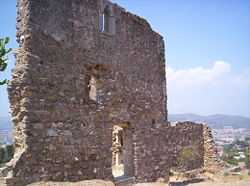Molins de Rei
| Molins de Rei | ||
|---|---|---|
| Municipality | ||
 | ||
| ||
 Molins de Rei | ||
| Coordinates: 41°24′50″N 2°00′57″E / 41.41389°N 2.01583°E | ||
| Country |
| |
| Community |
| |
| Province | Barcelona | |
| Comarca | Baix Llobregat | |
| Government | ||
| • Mayor | Xavier Paz Penche | |
| Area | ||
| • Total | 15.91 km2 (6.14 sq mi) | |
| Elevation | 37 m (121 ft) | |
| Population (2009) | ||
| • Total | 24,067 | |
| • Density | 1,500/km2 (3,900/sq mi) | |
| Demonym | Molinenc | |
| Time zone | CET (UTC+1) | |
| • Summer (DST) | CEST (UTC+2) | |
| Website | Official website | |
Molins de Rei (Catalan pronunciation: [muˈɫinz ðə ˈrej]) is a municipality located 18km from Barcelona's city centre, in the comarca of Baix Llobregat in Catalonia, Spain. It is situated on the left bank of the Llobregat river, on the A-7 autopista from Valencia to La Jonquera and the main N-II road.
Its location has made Molins de Rei a strategic and dynamic municipality, with significant examples of commercial and industrial entrepreneurship.
History
Its name, Molins de Rei (which means King's Mills), has its origins in the royal windmills that existed in this area, documented as early as 1188. These mills were built by order of the King Alfonso II, and their construction essentially established the municipality. By 1208, a parish and church as well as a cemetery had been built in the town.
In 1309, the town was part of the county of Pallars which belonged to the countess Sibil·la. When she died, the town changed owners to Hugo de Arborea and later on, it was transferred to the convent of Santa Clara in Sardinia (Italy). Again in 1366, the lands were purchased by Berenguer de Relat. In 1430, it was again transferred to Galceran de Requesens i de Santacoloma who built a palace in the village, visited by personalities of the time such as the Catholic Monarchs or Christopher Columbus.
In 1763 a bridge was built to cross the Llobregat river, by order of the King Charles III of Spain. This bridge turned the village into a strategic location during the Peninsular War, and the town was subjected to grave attacks and fires in several occasions. During these attacks, several significant buildings were destroyed, such as the Palace of Requesens.
Main sights
The Palace of Recasens, ruined by a looting during the 19th century, dates from the 15th century.
Outside the town are the ruins of the Castellciuró castle, built in 1066—perhaps over a previous Visigoth fortification— and destroyed in 985 by troops of al-Mansur Ibn Abi Aamir. Remains include a tower and parts of the walls.
The Romanesque chapel of Sant Pere de Romaní, known from 1011, has a rectangular shape, with a barrel vaulted ceiling, and a bell tower.
Transportation
The Molins de Rei train station is served by RENFE railway lines R1 and R4 which run frequently to and from central Barcelona, taking roughly 25 minutes to and from Plaça Catalunya.
Local buses also connect the town to central Barcelona and since it is in the Barcelona Metropolitan Area, a tourist will be able to find the distinctive yellow taxis in the square where the Avinguda de Barcelona and the Avinguda de València meet.
In addition, the town is served by the C-1413 road to Sabadell.
Notable people
- Luis de Requesens y Zúñiga, 16th century Spanish diplomat and politician
- Agustí Roc Amador (born 1971), ski mountaineer and long-distance runner
- Josep Maria Madorell (1923 - 2004), Well-known artist. Author of comics like "Massagran".
- Margarita Xirgu, international actress. (18 June 1888– 25 April 1969, Montevideo, (Uruguay)) was a Catalan stage actress, who was greatly popular throughout her country and Latin America. A friend of the poet Federico García Lorca, she was forced into exile during Francisco Franco's dictatorship of Spain, but continued her work in America. Notable plays in which she appeared include "Como tú me Deseas", "La Casa de Bernarda Alba", and "Mariana Pineda".
An opera, Ainadamar, by the composer Osvaldo Golijov and playwright David Henry Hwang, based on Xirgu's life and her association with Lorca, premiered in 2003. A recording of the work released in 2006 on the Deutsche Grammophon label (Catalog #642902) won the 2007 Grammy awards for Best Classical Contemporary Composition and Best Opera Recording.
Twin towns
 Lorca, Spain
Lorca, Spain Chinandega, Nicaragua
Chinandega, Nicaragua
References
- Panareda Clopés, Josep Maria; Rios Calvet, Jaume; Rabella Vives, Josep Maria (1989). Guia de Catalunya, Barcelona:Caixa de Catalunya. ISBN 84-87135-01-3 (Spanish). ISBN 84-87135-02-1 (Catalan).
| |||||||

.svg.png)